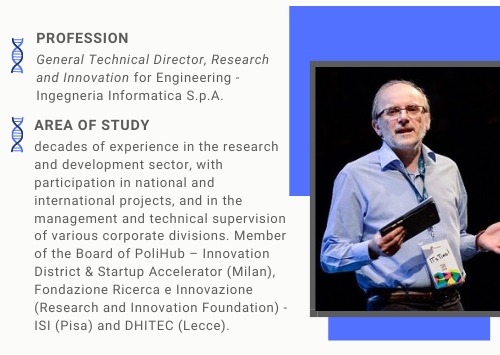Orazio Viele Interview

Engineering D.HUB is one of the project’s technological partners. What is its core business, and how is the company organised?
Engineering D.HUB is part of Gruppo Engineering, which for years has been part of the Italian and international technological landscape. Its principal mission is to supply its customers and partners with bespoke technological services, infrastructures and expertise designed according to their respective needs. In the company there is an entire division dedicated to cutting-edge R&D projects in the IT field, involved in over 70 international projects. Our objective is to develop an ongoing interchange and communication between innovation and the market launch of new, highly competitive, digitally-empowered technological solutions.
What experience does the company have in technological healthcare applications, apart from the 5000genomi@VdA project?
The Engineering Group offers its solutions in various fields: in healthcare, we are currently committed to the theme of biosurveillance and epidemiological assessment for the SARS-Cov-2 pandemic in some Italian regions, and in the supply of platforms and services used for telemedicine, which, as can easily be imagined, is already, and will increasingly be, used for better patient management, medical services at home and healthcare.
What form will the partnership between Engineering D.HUB and 5000genomi@VdA take? What is the company’s role within the project?
Engineering D.HUB, which has operational premises in Pont-Saint-Martin, considers 5000genomi@VdA as a fine opportunity and a great challenge, because it will enable us to implement our technological expertise while also contributing to a project that is genuinely important both for local healthcare and for the future of medicine. The company considers this a true “pilot project” that combines both scientific research and, above all, technological development. As well as co-financing the operation, we feel that it is important to develop new tools and knowledge in order to stay at the cutting edge of a new sector that is also closely linked to the themes in which we are already operating, namely the fight against COVID-19 and telemedicine.
What is the technology that CMP3VdA will be using?
In its role as main technological partner, Engineering D.HUB will supply CMP3VdA both with hardware infrastructures, including the high-performance computers (HPC) and the data centre located in Pont-Saint-Martin, and the expertise of our researchers, who are involved, in cooperation with the team at the Osservatorio Astronomico della Regione Autonoma Valle d'Aosta, in the development, specific programming and ongoing maintenance of the various software packages for genomic data analysis and interpretation.
It is very important to point out that all the equipment that will be used in the project is tailored to its roles, comprising various areas of technology, artificial intelligence and machine learning algorithms based on scientific needs. Some of those infrastructures are already up-and-running and used by our collaborators and by the young research scholars working on the project. Of course, data connections and transfers are protected by high band technology and encryption in order to guarantee their security and privacy.
One of the objectives of the 5000genomi@VdA project is the creation of the “health records of the future”. How can this be achieved?
The healthcare record of the future can be imagined as a sort of “universal” digital biological identity that comprises patients’ entire clinical background and medical test results, regardless of their origin and the healthcare providers that they have used. Currently the major challenge for the Italian healthcare system is to facilitate the transfer of information amongst the various public and private structures, so that, by way of example, a patient from the Lazio region can be treated by a physician in the Aosta Valley, because the latter has digital access to all the updated information regarding that person’s state of health. This requires large investments and ambitious work on nationwide IT systems, a particularly difficult task in a country that currently has 21 different regional health authorities, each with its own characteristics.
One of the fundamental objectives of the 5000genomi@VdA project is that of initiating and improving this process in the Aosta Valley by creating an integrated health record that includes all the relevant data, comprising that arriving from the patient’s DNA sequencing, the so-called “last piece of the puzzle”. In order to achieve this, the scholarship winners, researchers and software developers are already at work, in close cooperation with the clinical staff who, along with citizens, will be the end-users of this innovative service, the first step towards precision medicine.
How will the technological panorama of diagnostics and medicine develop over the next few years?
The use of technology and artificial intelligence in diagnostic decision-making procedures is in a state of rapid, ongoing development: sometimes it is difficult, even for physicians, to stay constantly updated. This process has been further highlighted by the current situation that we are experiencing, polarised by the pandemic. Without doubt, two of the major trends in future healthcare will be the ever-more frequent use of telemedicine, by means of the integration of new platforms and apps with the infrastructures that are already available, and the use of genomics for access to increasingly personalised and effective treatments, “tailored” to each patient’s characteristics and requirements. However, all these “technological revolutions” will have to be sustained by a parallel, radical, cultural change in the approach to, and preparation for, the use of these tools, both by healthcare professionals and, above all, by patients themselves.
(interview: Sept 2020)



